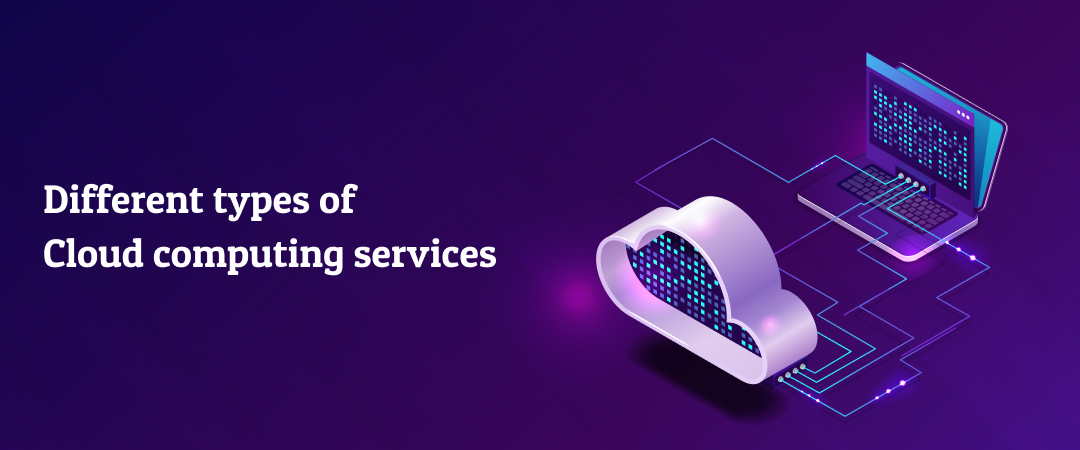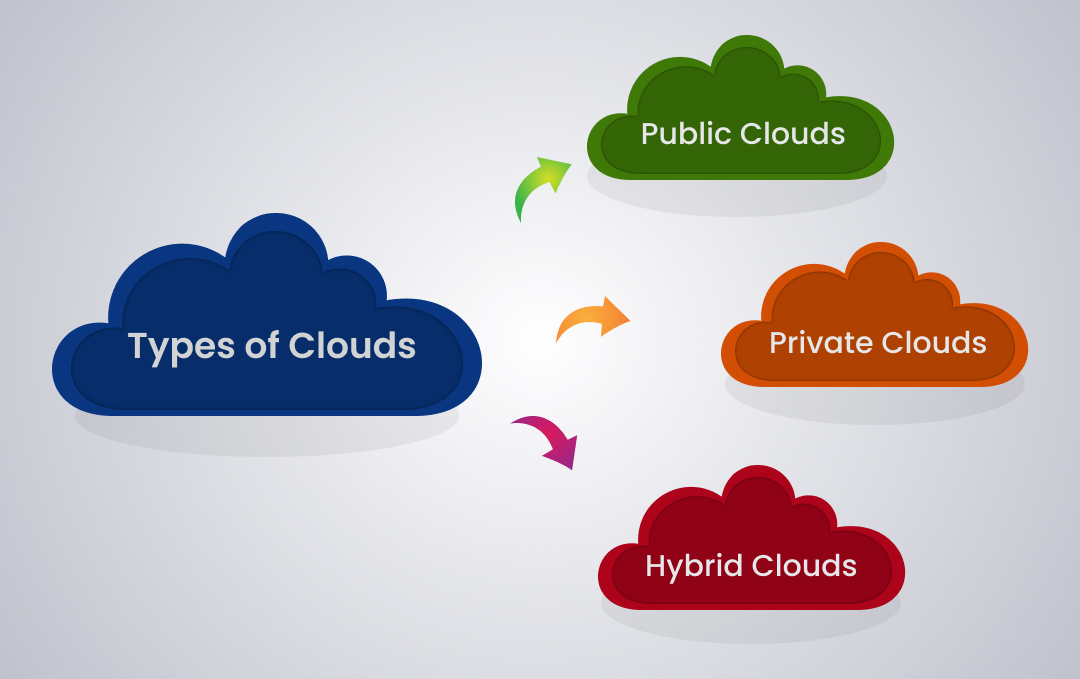
Different types of Cloud Computing Services – An Explanatory

“Cloud” has become an integral part of our lives even without us realizing it. If you are using a smartphone, you are already a part of the cloud service. In case you want to save a new contact, the message you receive is to save the number on the phone or with google. Here, “Google” implies that ‘cloud’. Where do you think your innumerable photos, comments, and videos you upload to your Facebook account get stored? The answer is ‘Cloud’. Remote working during the recent pandemic became a possibility because your software and operating tools are placed in the Cloud.
Cloud computing is a service provided by a third party for accessing services inclusive of storing data, applications, and servers through the internet. They charge a certain amount as fees for the facility and their database is situated globally at various remote locations. Companies using them can store and utilize their data virtually rather than through local drivers and servers.
Evolution of Cloud computing
The word ‘Cloud computing’ is often equated to an innovation of the 21st century. However, its evolution is traced to the early 1950s. Mainframe computers allowed multiple users to access a central computer through various terminals. But it was aborted as it was not cost-effective.
The 70s gave birth to Virtual Machine (VM) where multiple operating systems can be executed simultaneously by the user from one physical environment. When computer virtuals are executed in one computer hardware can run the different operating systems. This virtualization served as a catalyst for both communication and information technology.
In the 1990s, telecommunications companies started using virtualized private network connections where users get shared access to the same physical infrastructure at a reduced cost. Google came into the frame as a search engine.
In the 2000s, various cloud services started penetrating the market at intermittent intervals. Their acronym is FANG companies (Facebook, Amazon, Netflix, and Google). The cloud concept in the 2010s changed with ‘open source’ becoming a reality.
Cloud computing in the zeitgeist
This rapid growth of technology & internet created pathways for interdependence and became indispensable in day-to-day lives. Keeping pace with the times, ‘Cloud computing’ apart from storing data, extends its services in the form of databases, networking, software, analytics, and intelligence.
According to IT research consultant Gartner Inc, worldwide end-user spending on public cloud services is forecast to grow 20.7% to a total of $591.8 billion in 2023, up from $490.3 billion in 2022.What propels this astronomical growth that firms move their IT platform to ‘Cloud computing?
- Augments security to the information stored.
- Accessibility to the innovations trending in the market.
- Accelerates application development and installation of new functions.
- Allows customized scalability and
- Affordable overall costs.
Let us discuss the types of clouds – they are categorized as

Public Cloud
Private Cloud
Hybrid Cloud
This is the most prominent type of cloud. There are major cloud service providers in the market, namely Google, Microsoft, and Amazon. They own the servers, create the infrastructure, and handle the hardware & software for operating the cloud. All you have to do is choose and subscribe to the cloud service provider.
Once done, it is implied that all subscribers utilize the same service provider resources.
As the name suggests, a single organization exclusively utilizes it. Either they own the server, or the service provider creates the infrastructure, hardware, and software specifically for them.
Many well-established organizations prefer to have the privilege of a ‘Private Cloud’. The main reasons that can be stated are for managing purposes, security of confidential data, the flexibility of operations, and customization to their specific needs.
A hybrid cloud is a fusion of public, private, and on-premise infrastructure. There is a reasonable demand for this type of facility. The major attraction is that firms utilize the public cloud for basic computing tasks, whereas for storing confidential data, they use the services of a private cloud. While enjoying the benefits of both worlds, they secure their sensitive information as well as the scalability of the cloud.
We are not limited to just the different types of clouds; there are distinct varieties of cloud services. Let us walk you through them.
Infrastructure as a Service (IaaS)
laaS is one of the main computing services which provides resources through the internet. Under this model, a third party provides all the hardware resources like storage, servers, and network. The subscriber gets access to the infrastructure, but the software must be purchased, deployed, configured and maintained by them. It is inclusive of operating systems, applications, and middleware.
Windows Azure, Amazon EC2, and Google Compute Engine provide this service.
Merits of laaS
- SMBs and even large firms having a financial crunch can opt for this model as the infrastructure is readily available.
- Payment is made as per the utility value of the services used.
- The flexibility to scale as per the operational requirement is available.
Demerits of laaS
- Security lapses are possible and must be appropriately reviewed regarding the safety measures used.
- Rare cases of service providers not interested in upgrading their resources.
Potential areas for laaS usage
- Companies working with ‘humongous data’ gives them leeway to increase their computing power.
- Less time is taken for deployment and flexibility to scale applications up and down based on demand.
- Setting up and testing the environment is comparatively rapid and cheaper.
- Immense storage capacity, backup facility and recovering data are feasible.
Platform as a Service (PaaS)
Along with providing the IT hardware infrastructure like servers, storage, and networking. They include and manage the operating system, middleware, and solution stack as a service.
This model is highly beneficial to users for creating cloud-based customized applications. It supports building, managing, testing, deploying, and enhancing web and mobile applications.
Some of the services offered are Hosting solutions, network access, server software, DBMS, and software tools for design and development.
This service is provided by Windows Azure, Google app engine, OpenShift, Apache Stratos and Rackspace cloud sites.
Merits of PaaS
- The upgrade of PaaS services like a software upgrade, update patches or maintenance is not the concern of the users. It is taken care of in its entirety, along with the hardware infrastructure.
- Software development becomes easier as individuals with an idea and modest technical expertise can build an application.
- Initiate investment for building infrastructure and software is diluted. What is required is to subscribe to use the facilities.
- Individuals from diverse locations can work together on the same platform.
Demerits of PaaS
- Customization is not feasible, so applications or services can be incompatible with this platform. Therefore, additional expenditure may incur to synchronize with this setup.
- If the service provider makes modifications, their new design can conflict with your present working model.
- Programming languages and frameworks utilized by the user can face runtime issues when the platform is unharmonious.
Potential areas for PaaS usage
- Facilitates various applications, environments, tools and programming languages to connect and integrate as needed in loT deployments.
- Flexible to cope with advanced data analysis, recognize and foresee patterns and conclude with data-driven decision-making.
- Features of communication (videos, audio and chat) can be added to applications built on this premise.
Software as a Service (SaaS)
- SaaS service embodies both the services of laaS and PaaS. Without many complications, it personalized the services to various verticals with ease.
- As the application functions through a browser interface, the users can access it through the internet. There is no requirement for a developer to utilize it.
- This service is provided by SAP Business ByDesign, Zoho CRM, AppDynamics, Microsoft Office 365, and Pardot Marketing Automation.
Merits of SaaS
- Users benefit from the subscription model and can withdraw when not required.
- There is no initial investment required for setup, and any updates of software are taken care of by the service providers.
- Flexible payment is made, and scaling is possible as per requirements.
- Smartphone and laptop devices accessed through the internet are compatible with SaaS applications.
Demerits of SaaS
- High-speed internet connectivity is needed; if the connection is weak, accessing the software programs becomes difficult.
- Performance issues of applications also become difficult at times, and it takes a longer time than anticipated.
- Security is another feature many businesses are reluctant to take advantage of.
Potential areas for SaaS usage
- Live events, shows, and tournaments where the usage is limited only to a few hours a day are well suited.
- Benefits for widely distributed and accessed applications, for example, google email or google drive, which allows access to mail or drives through the internet.
- Content owners are in an advantageous position as their content reaches consumers directly, as deployment covers all.
Functions as a Service (FaaS)
FaaS as a service model is a new concept becoming the ‘talk of the town’. Its uniqueness is its serverless computing idea. All a software developer has to do is develop an application and deploy them as a ‘function’. The hosting aspect is taken care of externally. The service provider takes care of the bottom-level decisions of infrastructure, server management, and resource allocation.
AWS Lambda, Open Whisk, and Google Cloud function provide this type of service.
Merits of FaaS
- Better utilization of valuable resources for product development.
- Server issues or logistics are not a priority for developers, who concentrate on writing a better application.
- The window is open for scaling.
Before leaving, without any form of reservations, any type of cloud computing service is widely acceptable. Since it helps to reduce cost and enhance efficiency in business operations, the user should thoroughly research the nature of business and what cloud service will be fine-tuned before selecting the type of service needed.
iSQUARE deals with various forms of service as the end-user requirement. Our team has the caliber to understand your objectives, study the infrastructure and help you select the right Cloud computing services. Just dial to + 91 8012005000












